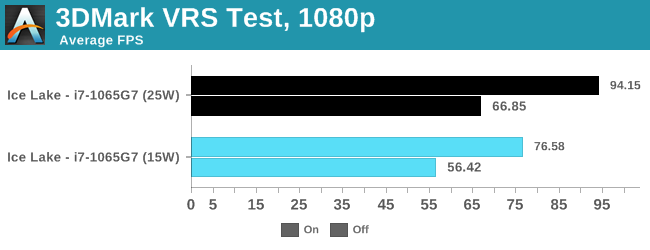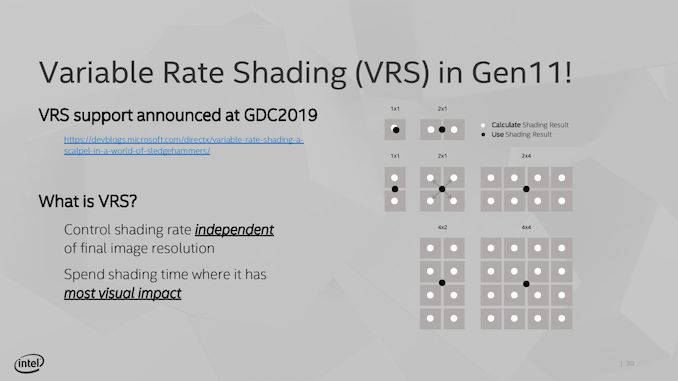The Ice Lake Benchmark Preview: Inside Intel's 10nm
by Dr. Ian Cutress on August 1, 2019 9:00 AM EST- Posted in
- CPUs
- Intel
- GPUs
- 10nm
- Core
- Ice Lake
- Cannon Lake
- Sunny Cove
- 10th Gen Core
Gaming Results (15W and 25W)
One of the biggest changes to the Ice Lake design is in the integrated graphics – Intel is now giving more focus and more die area to graphics, something it has arguably been neglecting for several years now. With Ice Lake, we move to a Gen11 graphics architecture, which is almost like the previous Gen9.5 but now with added support for variable rate shading (VRS), moving from 24 EUs to 64 EUs, and memory support up from LPDDR3-2133 to LPDDR4X-3733.


World of Tanks is a very CPU driven benchmark, and having the extra frequency of the 25W processor does help here. We're getting a sizeable uplift from Whiskey Lake, due to the extra EUs and memory frequency.


Our Final Fantasy test seemed to regress in 25W mode, although still within the noise. This test is still GPU bound, so adding the extra TDP to the CPU didn't actually help much. However, comparing to the Whiskey Lake integrated graphics, we've got over a 2x speedup.


Similarly with Civilization, with what is normally our 'IGP' settings, we are still GPU limited here.
One of Intel's newest features is Variable Rate Shading.
If developers add the option, soon to be an easy checkbox in Unity and Unreal, the game can decide to control the rate at which it shades pixels, from calculating every pixel down using one result across a 4x4 grid, to save compute power. Currently the only way to test this is with the 3DMark functional demo.

The new VRS test in 3DMark is designed as a feature test to show the potential uplift effect from enabling variable rate shading within a game. In both 15W and 25W modes, the data saw a good uplift, and we seemed to get more out of the 25W mode than the 15W mode.














261 Comments
View All Comments
Xyler94 - Sunday, August 4, 2019 - link
Slower in games, faster in almost everything else (when the R7 1800X came out, the i7 at the time was the i7 7700k)Just like today, the Ryzen 9 3900x is slightly slower in most games (beating it in others) while smashing the i9 9900k in almost any other task. Funny how now we have two CPUs for two different things, huh? Competition is good~
Thunder 57 - Sunday, August 4, 2019 - link
No point in trying to talk sense into a grade A troll. You would think AMD beat him with a belt as a kid or something.Korguz - Friday, August 2, 2019 - link
um HStewart, " Big difference is power difference 0 series are 9V while U is 15/28 and also 28." 9 volts??? again.. do you NOT not know the difference between WATTS and VOLTS ?? i guess by YOUR logic, U uses 15 and 28 VOLTS ????quadibloc - Friday, August 2, 2019 - link
It's easy to focus on AMD and say that the reason Intel didn't do a pure "tick" release this time was because it couldn't afford to pass up any opportunity for improvement in a more competitive environment. But this forgets another factor: during the years of the "tick-tock" strategy, Dennard Scaling was operative, so a process shrink of itself brought a major performance improvement.Now, without Dennard Scaling, even without serious competition from AMD, if Intel had brought out a process shrink without architectural improvements, people would have said "What's the point?".
0ldman79 - Friday, August 2, 2019 - link
Ignore the whiners.Good tech preview.
Looking forward to a full on review.
The SPEC numbers vs the 3900x are pretty insane. Is that single thread or what? Are the benches short enough to run within the max turbo power envelope?
I'm trying to understand how a 15W Ice Lake and 15W Whiskey Lake are comparable to a 9900K or 3900x.
Alistair - Friday, August 2, 2019 - link
Of course it is single threaded (Hence Ian saying words like IPC in that section). There are 0 reasons you'd pick this CPU to compete against the 3900x in multi core workloads.Phynaz - Friday, August 2, 2019 - link
Show me a laptop with a 3900x.Thought so.
Idiot.
Alistair - Saturday, August 3, 2019 - link
Are you dumb? Single core performance is equal, not multicore (it is 1/3 the speed).Xyler94 - Sunday, August 4, 2019 - link
Show me a laptop with an i9 9900ks which can handle the insane tdp it needs.Thought so,
Idiot
R6E7980XE - Saturday, August 3, 2019 - link
“For Sunny Cove this has increased, but it gets a bit more complicated. In one clock Sunny cove can perform 2x64-byte reads and either 1x64-byte write, or 1x32-byte write, or 2x16-byte writes.”@Ian Cuttress Please correct me if I’m remember wrong.
Sunny Cove Microarchitect consisted 2 x 64 Byte / cycle Load and 2 x 64 Byte / cycle Store.
according to https://en.wikichip.org/wiki/File:sunny_cove_block...